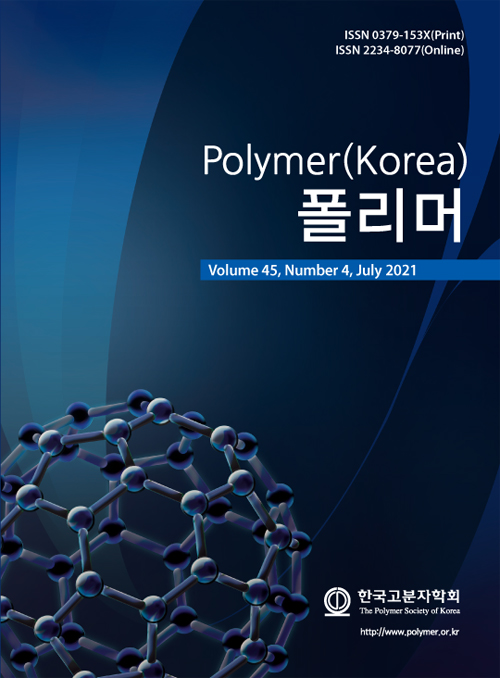- Synthesis and Characterization of Poly(lactic acid-co-glycolic acid-co-ε-caprolactone) and Its Pressure Sensitive Adhesive Property
School of Material Science and Engineering, East China University of Science and Technology, Shanghai 200237, China
- Poly(lactic acid-co-glycolic acid-co-ε-caprolactone)의 합성, 분석 및 감압 접착 특성
Reproduction, stored in a retrieval system, or transmitted in any form of any part of this publication is permitted only by written permission from the Polymer Society of Korea.
Random copolymers of poly(lactic acid-co-glycolic acid-co-ε-caprolactone) (PLGA-CL) based on lactic acid (LA), glycolic acid (GA), citric acid (CA), and e-caprolactone (CL) were synthesized and characterized. 1H NMR spectra showed that the polymerization conversion of various monomers was high under the experimental conditions, and the degree of polymerization of the polycaprolactone (PCL) segment increased with the growth of CL content. The content of CL has a remarkable effect on the decrease of glass transition temperature (Tg) of the copolymers. The adhesive properties of random copolymers as pressure-sensitive adhesive (PSA) were evaluated. With the increase of CL content, 180° peel strength, the shear strength and loop tack decreased. When CL content was 16.7 wt%, 180° peel strength was 4.76 N/25 mm, and loop tack was 8.45 N/25 mm.
Keywords: poly(lactic acid-co-glycolic acid), ε-caprolactone, glass transition temperature, pressure-sensitive adhesive property.
- Polymer(Korea) 폴리머
- Frequency : Bimonthly(odd)
ISSN 0379-153X(Print)
ISSN 2234-8077(Online)
Abbr. Polym. Korea - 2023 Impact Factor : 0.4
- Indexed in SCIE
 This Article
This Article
-
2021; 45(4): 592-600
Published online Jul 25, 2021
- 10.7317/pk.2021.45.4.592
- Received on Mar 17, 2021
- Revised on Apr 20, 2021
- Accepted on Apr 22, 2021
 Correspondence to
Correspondence to
- Zhean Xia
-
School of Material Science and Engineering, East China University of Science and Technology, Shanghai 200237, China
- E-mail: xiazhean@ecust.edu.cn









 Copyright(c) The Polymer Society of Korea. All right reserved.
Copyright(c) The Polymer Society of Korea. All right reserved.